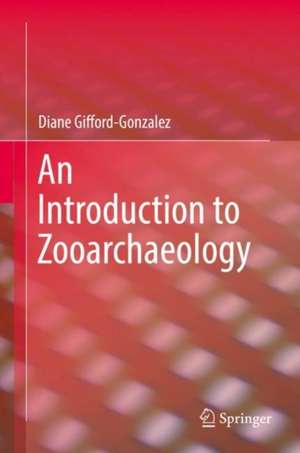An Introduction to Zooarchaeology
Autor Diane Gifford-Gonzalezen Limba Engleză Hardback – 13 apr 2018
| Toate formatele și edițiile | Preț | Express |
|---|---|---|
| Paperback (1) | 511.61 lei 38-44 zile | |
| Springer International Publishing – 21 dec 2018 | 511.61 lei 38-44 zile | |
| Hardback (1) | 683.66 lei 38-44 zile | |
| Springer International Publishing – 13 apr 2018 | 683.66 lei 38-44 zile |
Preț: 683.66 lei
Preț vechi: 887.87 lei
-23% Nou
Puncte Express: 1025
Preț estimativ în valută:
130.86€ • 142.19$ • 109.99£
130.86€ • 142.19$ • 109.99£
Carte tipărită la comandă
Livrare economică 17-23 aprilie
Preluare comenzi: 021 569.72.76
Specificații
ISBN-13: 9783319656809
ISBN-10: 3319656805
Pagini: 384
Ilustrații: XXIII, 604 p. 137 illus., 4 illus. in color.
Dimensiuni: 155 x 235 x 36 mm
Greutate: 1.39 kg
Ediția:1st ed. 2018
Editura: Springer International Publishing
Colecția Springer
Locul publicării:Cham, Switzerland
ISBN-10: 3319656805
Pagini: 384
Ilustrații: XXIII, 604 p. 137 illus., 4 illus. in color.
Dimensiuni: 155 x 235 x 36 mm
Greutate: 1.39 kg
Ediția:1st ed. 2018
Editura: Springer International Publishing
Colecția Springer
Locul publicării:Cham, Switzerland
Cuprins
Section 1: An Orientation to Zooarchaeology.- Chapter 1. Introduction.- Chapter 2. The Emergence of Zooarchaeology.- Chapter 3. A Perspective on Zooarchaeology.- Section 2: The Evidence- Vertebrate Bodies.- Chapter 4. Bone and Vertebrate Bodies as Uniformitarian Materials.- Chapter 5. Bone’s Intrinsic Traits: Why Animals Eat Animals.- Chapter 6. Bone’s Intrinsic Traits: Inferring Species, Sex, and Age.- Chapter 7. Bone’s Intrinsic Traits: Age Estimation from Mammalian Dentition.- Section 3: Basic Practical Approaches.- Chapter 8. Field Recovery, Lab Methods, Data Records, Curation.- Chapter 9. Identification: Sorting Decisions and Analytic Consequences.- Chapter 10. Zooarchaeology’s Basic Counting Units.- Section 4: Identifying Causal Process, Effector, Actor.- Chapter 11. Human, Animal, and Geological Causes of Bone Breakage.- Chapter 12. Mammalian and Reptilian Carnivore Effects on Bone.- Chapter 13. Avian Carnivore, Ungulate, and Effects on Bone.- Chapter 14. Primary Human Effects: Cutting Edge and Percussion Effects on Bone.- Chapter 15. Culinary Processing and Preservational Effects on Bone.- Chapter 16. Invertebrate, Plant, and Geological Effects on Bone.- Section 5: Studying Behavioral, Social, Ecological Contexts.- Chapter 17. Analyzing Multi-Agent Assemblages.- Chapter 18. Reasoning with Zooarchaeological Counting Units and Statistics.- Chapter 19. Skeletal Disarticulation, Dispersal, Dismemberment, Selective Transport.- Chapter 20. Calibrating Nutritionally Driven Selective Transport.- Chapter 21. Calibrating Bone Durability.- Chapter 22. Zooarchaeology and Ecology: Mortality Profiles, Species Abundance, Diversity.- Chapter 23. New Ecological Directions: Isotopes, Genetics, Historical Ecology, Conservation.- Chapter 24. Behavioral Ecology and Zooarchaeology.- Chapter 25. Social Relations through Zooarchaeology.- Conclusion.- Chapter 26. Doing Zooarchaeology Today and Tomorrow.
Recenzii
“Zooarchaeology is the study of animal remains from archaeological deposits. Gifford-Gonzalez (emer., Univ. of California, Santa Cruz) has worked on such remains for nearly 40 years, with an emphasis on vertebrates (especially mammals) from early agricultural contexts. … the text covers aspects of interpretation, including human interaction with prey animals, human behavioral ecology and group relations, and some thoughts for the future of zooarchaeology. … Summing Up: Highly recommended. Advanced undergraduates and above.” (E. Delson, Choice, Vol. 56 (03), November, 2018)
Notă biografică
Diane Gifford-Gonzalez is among the first cohort of archaeologists trained in faunal analysis and has authored numerous publications, including many widely cited as major formulations of zooarchaeological theory and method. She takes an international perspective, having researched in Africa and western North America and offered advanced seminars and workshops in the USA, Argentina, China, Kenya, Norway, and Spain. She is an elected member of the Committee of Honor, International Council of Archaeozoology (ICAZ).
Textul de pe ultima copertă
This volume is a comprehensive, critical introduction to vertebrate zooarchaeology, the field that explores the history of human relations with animals from the Pliocene to the Industrial Revolution. The book is organized into five sections, each with an introduction, that leads the reader systematically through this swiftly expanding field. Section One presents a general introduction to zooarchaeology, key definitions, and an historical survey of the emergence of zooarchaeology in the Americas, Europe, Asia, and Africa, and introduces the conceptual approach taken in the book. This volume is designed to allow readers to integrate data from the book along with that acquired elsewhere within a coherent analytical framework. Most of its chapters take the form of critical “review articles,” providing a portal into both the classic and current literature and contextualizing these with original commentary. Summaries of findings are enhanced by profuse illustrations bythe author and others.
Caracteristici
Provides a comprehensive and conceptually coherent introduction to Zooarchaeology? ? Offers a profusely illustrated and well-documented critical literature review of the effects of specific bone-modifying actors and processes Discusses the contributions of zooarchaeologists’ to ecology and conservation
